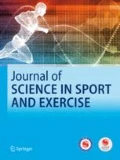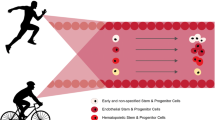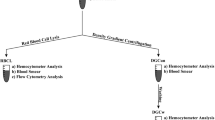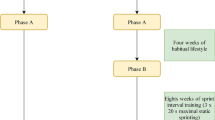Abstract
Introduction
Hematopoietic stem and progenitor cells (HSPC) are responsible for the reconstitution of blood cells and thought to contribute to peripheral tissue repair. Following acute exercise in young adults, HSPC are mobilized from their niche in bone marrow into circulation, however the kinetics of mobilization following exercise is not well understood in older adults. In the present study, we aimed to investigate how exercise intensity influences mobilization of specific subpopulations of HSPC, and how mobilization is affected by aging.
Methods
Healthy older men (OM; 69.9 ± 2.0 years) and young men (YM; 21.5 ± 0.8 years) performed three separate bouts of exercise on a cycle ergometer: 70% of their peak work rate (WRpeak) until volitional fatigue, 30% of their WRpeak work matched to the 70% WRpeak trial, and a high intensity interval training (HIIT) trial. Blood samples were collected before, immediately post, and 10, 30, and 60 min post-exercise. Total blood cells, hematocrit, and mononuclear cells isolated by density gradient centrifugation were quantified using flow cytometry.
Results
Mononuclear cells, CD34+, CD34+/CD38+, CD34+/CD110+, CD3+/CD(16 + 56)+, CD11c+/CD123−, and CD11c−/CD123+ cells per millilitre of blood increased immediately post-exercise, but predominately in the 70% WRpeak trial in both OM and YM.
Conclusion
Taken together, our evidence suggests that higher intensity exercise but also volume is necessary for the mobilization of HSPC. Furthermore, the pattern of mobilization was nearly identical in OM as compared to YM though to a lesser extent than their younger counterparts.





Similar content being viewed by others
References
Agha NH, Baker FL, Kunz HE, Graff R, Azadan R, Dolan C, Laughlin MS, Hosing C, Markofski MM, Bond RA, Bollard CM, Simpson RJ. Vigorous exercise mobilizes CD34 + hematopoietic stem cells to peripheral blood via the β2-adrenergic receptor. Brain Behav Immun. 2018;68:66–75. https://doi.org/10.1016/j.bbi.2017.10.001.
Antunes BM, Campos EZ, Thomatieli RV, dos Santos J, Rosa-Neto C, Franchini E, Bishop NC, Lira FS. Anti-inflammatory response to acute exercise is related with intensity and physical fitness. J Cell Biochem. 2019;120(4):5333–42. https://doi.org/10.1002/jcb.27810.
Attar EC, Scadden DT. Regulation of hematopoietic stem cell growth. Leukemia. 2004;18(11):1760–8. https://doi.org/10.1038/sj.leu.2403515.
Baker JM, Nederveen JP, Parise G. Aerobic exercise in humans mobilizes HSCs in an intensity-dependent manner. J Appl Physiol. 2017;122(1):182. https://doi.org/10.1152/japplphysiol.00696.2016.
Benbassat CA, Maki KC, Unterman TG. Circulating levels of insulin-like growth factor (IGF) binding protein-1 and -3 in aging men: relationships to insulin, glucose, IGF, and dehydroepiandrosterone sulfate levels and anthropometric measures. J Clin Endocrinol Metab. 1997;82(5):1484–91. https://doi.org/10.1210/jcem.82.5.3930.
Bonsignore MR, Morici G, Riccioni R, Huertas A, Petrucci E, Veca M, Mariani G, Bonanno A, Chimenti L, Gioia M, Palange P, Testa U. Hemopoietic and angiogenetic progenitors in healthy athletes: different responses to endurance and maximal exercise. J Appl Physiol. 2010;109(1):60–7. https://doi.org/10.1152/japplphysiol.01344.2009.
Bonsignore MR, Morici G, Santoro A, Pagano M, Cascio L, Bonanno A, Abate P, Mirabella F, Profita M, Insalaco G, Gioia M, Vignola AM, Majolino I, Testa U, Hogg JC. Circulating hematopoietic progenitor cells in runners. J Appl Physiol. 2002;93(5):1691–7. https://doi.org/10.1152/japplphysiol.00376.2002.
Dean R, Masci P, Pohlman B, Andresen S, Serafino S, Sobecks R, Kuczkowski E, Curtis J, Maciejewski J, Rybicki L, Kalaycio M, Hsi E, Theil K, Bolwell BJ. Dendritic cells in autologous hematopoietic stem cell transplantation for diffuse large B-cell lymphoma: graft content and post transplant recovery predict survival. Bone Marrow Transplant. 2005;36(12):1049–52.
De Lisio M, Parise G. Characterization of the effects of exercise training on hematopoietic stem cell quantity and function. J Appl Physiol (1985). 2012;113(10):1576–84.
Emmons R, Niemiro GM, Owolabi O, De Lisio M. Acute exercise mobilizes hematopoietic stem and progenitor cells and alters the mesenchymal stromal cell secretome. J Appl Physiol. 2016;120(6):624–32. https://doi.org/10.1152/japplphysiol.00925.2015.
Frystyk JAN. Exercise and the growth hormone-insulin-like growth factor axis. Med Sci Sports Exerc. 2010;42(1):58–66. https://doi.org/10.1249/MSS.0b013e3181b07d2d.
Fuss IJ, Kanof ME, Smith PD, Zola H. Isolation of whole mononuclear cells from peripheral blood and cord blood. Current protocols in immunology, Chapter 7: Unit 7.1. New York: Wiley; 2009. https://doi.org/10.1002/0471142735.im0701s85.
Garvin K, CF J, Sharp G, Berger A. Does the number or quality of pluripotent bone marrow stem cells decrease with age? Clin Orthop Relat Res. 2007;465:202–7. https://doi.org/10.1097/BLO.0b013e318159a9b8.
Gibala MJ, Little JP, Macdonald MJ, Hawley JA. Physiological adaptations to low-volume, high-intensity interval training in health and disease. J Physiol. 2012;590(5):1077–84. https://doi.org/10.1113/jphysiol.2011.224725.
Giralt S, Costa L, Schriber J, DiPersio J, Maziarz R, McCarty J, Shaughnessy P, Snyder E, Bensinger W, Copelan E, Hosing C, Negrin R, Petersen FB, Rondelli D, Soiffer R, Leather H, Pazzalia A, Devine S. Optimizing autologous stem cell mobilization strategies to improve patient outcomes: consensus guidelines and recommendations. Biol Blood Marrow Transplant. 2014;20(3):295. https://doi.org/10.1016/j.bbmt.2013.10.013.
Guardiola P, Runde V, Bacigalupo A, Ruutu T, Locatelli F, Boogaerts MA, Pagliuca A, Cornelissen JJ, Schouten HC, Carreras E, Finke J, van Biezen A, Brand R, Niederwieser D, Gluckman E, de Witte TM, Subcommittee for Myelodysplastic Syndromes of the Chronic Leukaemia Working Group of the European Blood and Marrow Transplantation Group. Retrospective comparison of bone marrow and granulocyte colony-stimulating factor-mobilized peripheral blood progenitor cells for allogeneic stem cell transplantation using HLA identical sibling donors in myelodysplastic syndromes. Blood. 2002;99(12):4370–8.
Hasegawa Y, Sawada M, Ozaki N, Inagaki T, Suzumura A. Increased soluble tumor necrosis factor receptor levels in the serum of elderly people. Gerontology. 2000;46(4):185–8. https://doi.org/10.1159/000022157.
Hénon PH, Sovalat H, Bourderont D. Importance of CD34 + cell subsets in autologous PBSC transplantation: the mulhouse experience using CD34 + CD38-cells as predictive tool for hematopoietic engraftment. J Biol Regul Homeost Agents. 2001;15(1):62–7. http://www.ncbi.nlm.nih.gov/pubmed/11388746.
Lee J, Yoon S, Choi I, Jung H. Causes and mechanisms of hematopoietic stem cell aging. Int J Mol Sci. 2019;20(6):1272. https://doi.org/10.3390/ijms20061272.
Longo DL. Bone marrow in aging: changes? Yes; clinical malfunction? Not so clear. Blood. 2008;112(11):sci-1.
Milone G, Martino M, Spadaro A, Leotta S, Di Marco A, Scalzulli P, Cupri A, Di Martina V, Schinocca E, Spina E, Tripepi G. Plerixafor on-demand combined with chemotherapy and granulocyte colony-stimulating factor: significant improvement in peripheral blood stem cells mobilization and harvest with no increase in costs. Br J Haematol. 2014;164(1):113–23. https://doi.org/10.1111/bjh.12606.
Morici G, Zangla D, Santoro A, Pelosi E, Petrucci E, Gioia M, Bonanno A, Profita M, Bellia V, Testa U, Bonsignore MR. Supramaximal exercise mobilizes hematopoietic progenitors and reticulocytes in athletes. Am J Physiol Regul Integr Comp Physiol. 2005;289(5):R1496–503. https://doi.org/10.1152/ajpregu.00338.2005.
Niemiro GM, Parel J, Beals J, Van Vliet S, Paluska SA, Moore DR, Burd NA, De Lisio M. Kinetics of circulating progenitor cell mobilization during submaximal exercise. J Appl Physiol. 2017;122(3):675–82. https://doi.org/10.1152/japplphysiol.00936.2016.
Nilsson MI, Bourgeois JM, Nederveen JP, Leite MR, Hettinga BP, Bujak AL, May L, Lin E, Crozier M, Rusiecki DR, Moffatt C, Azzopardi P, Young J, Yang Y, Nguyen J, Adler E, Lan L, Tarnopolsky MA. Lifelong aerobic exercise protects against inflammaging and cancer. PLoS One. 2019;14(1):e0210863. https://doi.org/10.1371/journal.pone.0210863(Edited by Antonio Musaro).
Pedersen BK, Åkerström TCA, Nielsen AR, Fischer CP. Role of myokines in exercise and metabolism. J Appl Physiol. 2007;103(3):1093–8. https://doi.org/10.1152/japplphysiol.00080.2007.
Porrata LF, Gastineau DA, Padley D, Bundy K, Markovic SN. Re-infused autologous graft natural killer cells correlates with absolute lymphocyte count recovery after autologous stem cell transplantation. Leuk Lymphoma. 2003;44(6):997–1000. https://doi.org/10.1080/1042819031000077089.
Puchta A, Naidoo A, Verschoor CP, Loukov D, Thevaranjan N, Mandur TS, Nguyen PS, Jordana M, Loeb M, Xing Z, Kobzik L, Larché MJ, Bowdish DM. TNF drives monocyte dysfunction with age and results in impaired anti-pneumococcal immunity. PLoS Pathog. 2016;12(1):e1005368. https://doi.org/10.1371/journal.ppat.1005368.
Pusic I, Jiang SY, Landua S, Uy GL, Rettig MP, Cashen AF, Westervelt P, Vij R, Abboud CN, Stockerl-Goldstein KE, Sempek DS, Smith AL, DiPersio JF. Impact of mobilization and remobilization strategies on achieving sufficient stem cell yields for autologous transplantation. Biol Blood Marrow Transplant. 2008;14(9):1045–56. https://doi.org/10.1016/j.bbmt.2008.07.004.
Ross MD, Malone EM, Simpson R, Cranston I, Ingram L, Wright GP, Chambers G, Florida-James G. Lower resting and exercise-induced circulating angiogenic progenitors and angiogenic T cells in older men. Am J Physiol Heart Circ Physiol. 2018;314(3):H392–402. https://doi.org/10.1152/ajpheart.00592.2017.
Sartor MM, Garvin F, Antonenas V, Bradstock KF, Gottlieb DJ. Failure to achieve a threshold dose of CD34 + CD110 + progenitor cells in the graft predicts delayed platelet engraftment after autologous stem cell transplantation. Bone Marrow Transplant. 2007;40(9):851–7. https://doi.org/10.1038/sj.bmt.1705818.
Shastri A, Budhathoki A, Barta SK, Kornblum N, Derman O, Battini R, Raghupathy R, Verma AK, Frenette PS, Braunschweig I, Janakiram M. Stimulation of adrenergic activity by desipramine enhances hematopoietic stem and progenitor cell mobilization along with G-CSF in multiple myeloma: a pilot study. Am J Hematol. 2017;92(10):1047–51. https://doi.org/10.1002/ajh.24843.
Solá C, Maroto P, Salazar R, Mesía R, Mendoza L, Brunet J, López-Pousa A, Tabernero JM, Montesinos J, Pericay C, Martínez C, Cancelas JA, López-López JJ. Bone marrow transplantation: prognostic factors of peripheral blood stem cell mobilization with cyclophosphamide and filgrastim (r-MetHuG-CSF): the CD34+ cell dose positively affects the time to hematopoietic recovery and supportive requirements after high-dose chemotherapy. Hematology. 1999;4(3):195–209.
Spodaryk K, Dabrowski Z. Blood flow in different regions of bone marrow after short-term exercise. Acta Physiol Hung. 1991;77(1):13–7. http://www.ncbi.nlm.nih.gov/pubmed/1950588.
Stabley JN, Moningka NC, Behnke BJ, Delp MD. Exercise training augments regional bone and marrow blood flow during exercise. Med Sci Sports Exerc. 2014;46(11):2107–12. https://doi.org/10.1249/MSS.0000000000000342.
Suzuki K, Shigeyuki N, Mutsuo Y, Manabu T, Koki S, Kazuo S. Systemic inflammatory response to exhaustive exercise. Cytokine kinetics. Exerc Immunol Rev. 2002;8:6–48. http://www.ncbi.nlm.nih.gov/pubmed/12690937.
Thijssen DHJ, Vos JB, Verseyden C, van Zonneveld AJ, Smits P, Sweep FC, Hopman MT, de Boer HC. Haematopoietic stem cells and endothelial progenitor cells in healthy men: effect of aging and training. Aging Cell. 2006;5(6):495–503. https://doi.org/10.1111/j.1474-9726.2006.00242.x.
Wardyn GG, Rennard SI, Brusnahan SK, McGuire TR, Carlson ML, Smith LM, McGranaghan S, Sharp JG. Effects of exercise on hematological parameters, circulating side population cells, and cytokines. Exp Hematol. 2008;36(2):216–23. https://doi.org/10.1016/j.exphem.2007.10.003.
Zaldivar F, Eliakim A, Radom-Aizik S, Leu S-Y, Cooper DM. The effect of brief exercise on circulating CD34 + stem cells in early and late pubertal boys. Pediatr Res. 2007;61(4):491–5. https://doi.org/10.1203/pdr.0b013e3180332d36.
Zhao M, Li L. Dissecting the bone marrow HSC niches. Cell Res. 2016;26(9):975–6. https://doi.org/10.1038/cr.2016.71.
Acknowledgements
G. P. was supported by a Natural Sciences and Engineering Research Council of Canada (NSERC) Grant (1455843), J. P. N. by a NSERC Canadian Graduate Scholarship (CGS-D).
Author information
Authors and Affiliations
Contributions
JPN, JMB, GP designed the study; JPN, GI, VI, MEP performed data acquisition; JPN, JMB, GI, VI, performed data analysis and interpretation; JPN, JMB, GP provided statistical expertise; JPN and GP wrote the manuscript; JPN, GI, VI, MEP, GP reviewed the manuscript.
Corresponding author
Rights and permissions
About this article
Cite this article
Nederveen, J.P., Baker, J., Ibrahim, G. et al. Hematopoietic Stem and Progenitor Cell (HSPC) Mobilization Responses to Different Exercise Intensities in Young and Older Adults. J. of SCI. IN SPORT AND EXERCISE 2, 47–58 (2020). https://doi.org/10.1007/s42978-019-00050-4
Received:
Accepted:
Published:
Issue Date:
DOI: https://doi.org/10.1007/s42978-019-00050-4




